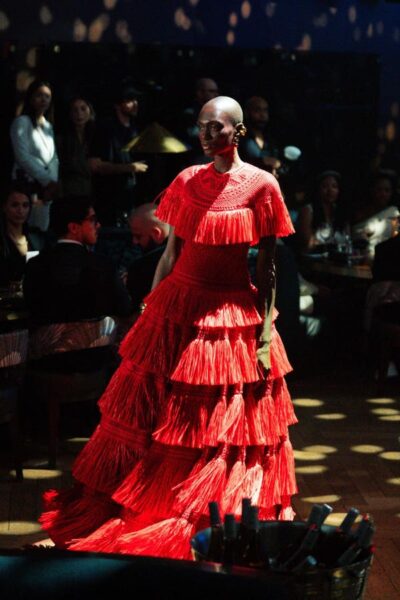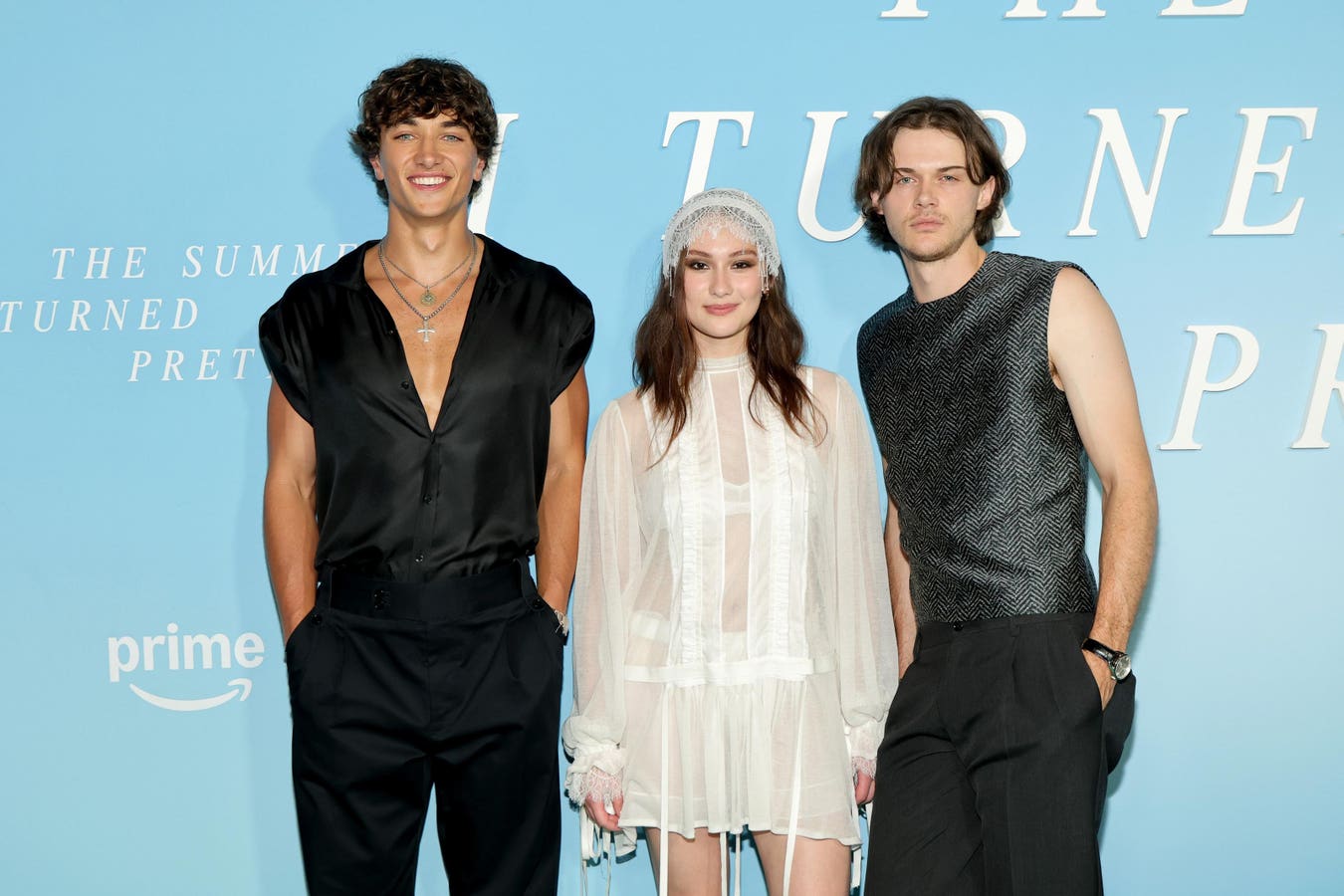Model wearing Naeem Khan dress made from cellulose material at his recent gala at Miami Fashion Week
Courtesy of Miami Fashion Week
At Miami Fashion Week 2025, sustainability was the pulse of the event. Designers and innovators redefined what it means to create responsibly. Among the most compelling voices were Naeem Khan, the celebrated Indian-American designer whose gowns have graced global red carpets, and Gabriella Smith, founder of the nonprofit Upcycle Project. Both demonstrated that sustainability is transformation rooted in craftsmanship, education, and human connection.
Naeem Khan Is Sustaining Beauty Through Craftsmanship In The Fashion Sector
Speaking in a interview after unveiling his Miami Fashion Week Gala Collection, Naeem Khan described it as a “menagerie of nine plants” a vibrant mix of his top designs from previous collections and new creations. Miami, he explained, is a significant market, representing “a weekend destination that reminds me of Mumbai because of the weather, color, and culture.”
Born into a family of Indian textile artisans, Khan’s philosophy is grounded in the legacy of craftsmanship. “My grandfather and father made saris and wedding dresses,” he reflected. That foundation shaped his identity long before his apprenticeship under legendary designer Halston, who taught him to “take the chaos of India and make it clean and modern.” That mantra has since defined Khan’s global aesthetic which is a balance of opulence and restraint, luxury and sustainability.
Models wearing Naeem Khan dresses showcasing the intricate designs
Courtesy of Miami Fashion Week
Tradition Meets Fashion Innovation
For Khan, innovation does not mean abandoning tradition, it means evolving it. “I have taken thousands of years of craftsmanship and made it modern to fit today’s woman,” he said. His supply chain, a global collaboration with artisans from Italy, Spain, Japan, Germany, and India, represents decades of trust. “It’s a dance,” he explained, “where my suppliers understand my vision.”
His approach to sustainability is rooted in intentional material choice and human preservation. He works primarily with natural fibers like silk, cellulose, and rayon, complemented by organic dyes and a deliberate reduction in plastics and synthetic materials. Still, Khan’s realism sets him apart from greenwashing narratives. “I can never say I’m 100 percent organic,” he admitted, “but if I can even make a 40 percent difference, then yes I have made a difference.”
Naeem Khan and models at the recent Gala in Miami
Courtesy of Miami Fashion Week
Sustainability In Fashion Is Beyond Materials
Khan defines sustainability holistically: it’s about people, employment, and the continuity of craft. “If I make sustainable stuff but I’m not sustained, and I die because I’m hungry, it’s not sustainable.” That clarity underscores his mission to preserve traditional techniques through education. He would also like to develop plans for training ateliers where young artisans can learn embroidery, weaving, and design, ensuring skills are passed down rather than lost to automation.
His perspective on technology is equally grounded. For Khan, technology should amplify creativity, not replace the human hand that gives couture its soul.
For decades, he has maintained full creative and financial control of his brand by owning 100% of his company and avoiding outside capital. Now, after doubling his business, he is open to strategic investors aligned with his vision.
Spotlight shining on model wearing Naeem Khan at the recent Gala in Miami
Courtesy of Miami Fashion Week
“I want to start these ateliers where you’re catered to like a princess,” he shared, outlining plans. Each location will offer personalized couture experiences, from bridal wear to exquisite evening designs, made to a client’s exact measurements and specifications. “This could be a billion-dollar business,” he said confidently.
His proposed direct-to-consumer model will blend sustainability and luxury by eliminating unnecessary inventory, focusing instead on made-to-order couture that minimizes waste while maximizing individuality. Khan’s expansion strategy aim to fuse timeless craftsmanship with the efficiency of modern technology. This is an alignment that positions his brand as one of the most promising ethical-luxury growth ventures of the decade.
Empowering Artisans And Inspiring The Next Generation In Fashion
Khan’s relationships with his artisan partners span over 30–40 years, and he views empowerment as both moral and strategic. “You cannot imagine how many people are affected by my decisions,” he said. He offers stable employment, global exposure, and the chance to see their work on international icons, as a result, he turns fashion into a shared achievement. His advice to emerging designers is as practical as it is inspiring: “Understand your materials, create wearable art, stay sincere and kind, and believe in your creativity.”
Naeem Khan working with artisans
Courtesy of Naeem Khan
Gabriella Smith And The Upcycle Project Turns Fashion Waste Into Opportunity
If Khan represents sustainability at the couture level, Gabriella Smith is redefining it from the ground up. Her nonprofit Upcycle Project was born from a personal question: “What do we do with clothes we can’t donate?” When her son outgrew his school uniforms, Smith noticed that many items were too damaged or logoed to reuse. “That small frustration revealed a much larger problem,” she explained, over 11 million tons of textiles end up in U.S. landfills every year.
She was unable to unsee it. What began as curiosity became purpose, to prove that creativity can solve waste. “Sustainability doesn’t start in the factory,” she said. “It starts with the designer.” Today, Upcycle Project bridges education and industry, showing that creativity and responsibility can share the same fabric.
Upcycle Project is changing how we view fashion
Contributed by Up Cycle Project
From Landfill To A Fashion Learning Lab
Since 2017, Miami Fashion Week has been central to Upcycle Project’s journey. Its first donation came from unclaimed garments at local dry cleaners, which Smith brought to the Miami Fashion Institute at Miami Dade College. There, students re-imagined them in the first Upcycle Workshop, transforming forgotten clothing into wearable stories. That same year, Miami Fashion Week launched its Sustainability Summit, giving Upcycle Project a stage to showcase the results. It became a springboard that connected students, designers, and brands under a shared vision of creativity as climate action
Sustainability doesn’t start in the factory, It starts with the designer.
Contributed by UpCycle Project
At this year’s Summit, Smith said the response was electric: “People weren’t just listening; they were reflecting.” She recalled the moment when designers Yenny Bastida and Sitka Semsch discussed empowering women heads of households by teaching craftsmanship and restoring dignity through work. “That reminded everyone that sustainability isn’t just about materials, it’s about people,” she said. “When we talk about circularity, it’s not only what we make, it’s who we uplift in the process.”
The Innovate Upcycle Challenge Is Closing The Loop In Fashion
Upcycle Project operates as a reverse-logistics bridge between consumers, businesses, and recyclers. Its standout initiative which is the Innovate Upcycle Challenge, shows how collaboration can create tangible change. In partnership with MFI, the Miami Downtown Development Authority, and the JW Marquis Miami Hotel, students redesign the hotel’s retired linens and uniforms into wearable art. The winning designer receives a scholarship to study at MFI, a literal conversion of waste into opportunity
This partnership demonstrates measurable impact in a sector that currently recycles less than 15 percent of what it produces each year. As Smith put it, “We’re not just recycling fabric; we’re reshaping mindsets, inspiring future designers, and proving that sustainability and creativity can share the same runway.”
Naeem Khan and Gabriella Smith are redefining sustainability from opposite ends of the fashion spectrum, one through luxury, the other through circular education. Both show that progress in fashion will not come from slogans, but from systems that preserve skill, reduce waste, and create measurable value. Their work proves that sustainability is strongest when it balances artistry with accountability, creativity with continuity, and profit with purpose. In the end, that alignment is what will define the future of fashion.









